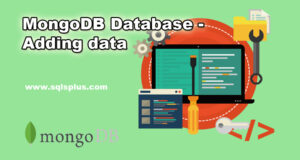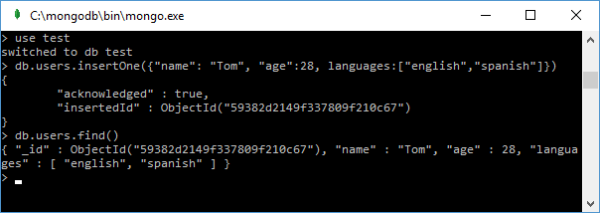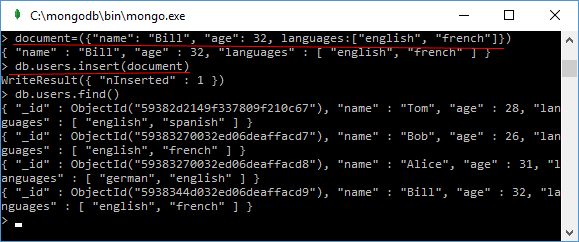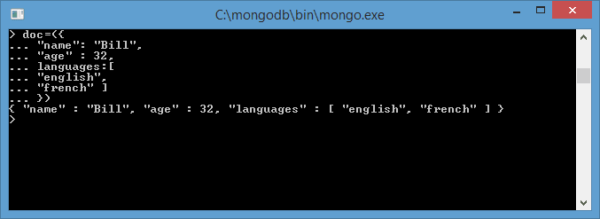REQUEST COMPLIMENTARY SQLS*PLUS LICENCE
MongoDB Database – Adding data

MongoDB Database – Having installed the DB, we can now add data to it. All data is stored in the DB in the BSON format, which is close to JSON, so we also need to enter data in this format.
And although we may not have a single collection at the moment, it is automatically created when we add data to it.
As mentioned earlier, the name of the collection is an arbitrary identifier consisting of no more than 128 different alphanumeric characters and an underscore.
At the same time, the name of the collection shall not start with the prefix system as it is reserved for internal collections (e.g. the collection system.users contains all database users). Also, the name shall not contain the dollar sign – $.
Three of its methods may be used to add to the collection:
- insertOne(): adds a single document
- insertMany(): adds several documents
- insert(): can add both one and several documents
So, let’s add one document:
> db.users.insertOne({"name": "Tom", "age": 28, languages: ["english", "spanish"]})
The document represents a set of key-value pairs. In this case, the document to be added has three keys: name, age, languages, and each of them is matched with a certain value. For example, the key languages are matched with an array as a value.
There are some limitations when using key names:
- The symbol $ cannot be the first character in the key name.
- The key name cannot contain the character of a.
When adding data, if we have not explicitly provided a value for the field “_id” (i.e. a unique document identifier), it is generated automatically. But in principle we can set this identifier ourselves when adding data:
> db.users.insertOne({"_id": 123457, "name": "Tom", "age": 28, languages: ["english", "spanish"]})
It should be noted that the key names can be used in quotes, or maybe without quotes.
If added successfully, the ID of the added document will be displayed on the console.
And to make sure that the document is in dd, we output it using the find function.
> db.users.find()

To print in a more readable form let’s add the pretty() method:
db.users.find().pretty()
If we need to add some documents, we can use the insertMany() method:
db.users.insertMany([{"name": "Bob", "age": 26, languages: ["english", "frensh"]},
{"name": "Alice", "age": 31, languages:["german", "english"]}])
After adding, the console displays the IDs of the added documents:

And the third method, insert(), demonstrates a more universal way to add documents. When it is called, the document to be added is also passed to it:
db.users.insert({"name": "Tom", "age": 28, languages: ["english", "spanish"]})
When it is called, the number of added entries is displayed on the console:
WriteResult({"nInserted" : 1 })
There is another way to add a document to the database, which includes two steps:
- the definition of the document (document = ( { … } )
- and the actual addition of the document:
If you want, you can also use db.users.find() function to verify that the document is in the database.

It may not be convenient for everyone to enter all key pairs and properties in one line. But the intelligent MongoDB interpreter based on javascript also allows you to enter multi-line commands.
If the expression is not finished (in terms of JavaScript), and you press Enter, the input of the next part of the expression will be automatically moved to the next line:

Loading data from a file
The data for the mongodb database can be defined in a regular text file, which is quite convenient because we can transfer or forward this file regardless of the mongodb database. For example, let’s define a users.js file somewhere on our hard drive with the following content:
db.users.insertMany([
{"name": "Alice", "age": 31, languages: ["english", "french"]},
{"name": "Lene", "age": 29, languages: ["english", "spanish"]},
{"name": "Kate", "age": 30, languages: ["german", "russian"]}
])
In other words, three documents are added to the user’s collection using the insertMany method.
To load a file into the current database, the load() function is used, in which the path to the file is passed as a parameter:
load("D:/users.js")
In this case, it is assumed that the file is located in the path “D:/users.js”.
MongoDB Tutorial: Insert Data Into MongoDB Database
MORE NEWS
PreambleNoSql is not a replacement for SQL databases but is a valid alternative for many situations where standard SQL is not the best approach for...
PreambleMongoDB Conditional operators specify a condition to which the value of the document field shall correspond.Comparison Query Operators $eq...
5 Database management trends impacting database administrationIn the realm of database management systems, moreover half (52%) of your competitors feel...
The data type is defined as the type of data that any column or variable can store in MS SQL Server. What is the data type? When you create any table or...
PreambleMS SQL Server is a client-server architecture. MS SQL Server process starts with the client application sending a query.SQL Server accepts,...
First the basics: what is the master/slave?One database server (“master”) responds and can do anything. A lot of other database servers store copies of all...
PreambleAtom Hopper (based on Apache Abdera) for those who may not know is an open-source project sponsored by Rackspace. Today we will figure out how to...
PreambleMongoDB recently introduced its new aggregation structure. This structure provides a simpler solution for calculating aggregated values rather...
FlexibilityOne of the most advertised features of MongoDB is its flexibility. Flexibility, however, is a double-edged sword. More flexibility means more...
PreambleSQLShell is a cross-platform command-line tool for SQL, similar to psql for PostgreSQL or MySQL command-line tool for MySQL.Why use it?If you...
PreambleWriting an application on top of the framework on top of the driver on top of the database is a bit like a game on the phone: you say “insert...
PreambleOracle Coherence is a distributed cache that is functionally comparable with Memcached. In addition to the basic function of the API cache, it...
PreambleIBM pureXML, a proprietary XML database built on a relational mechanism (designed for puns) that offers both relational ( SQL / XML ) and...
What is PostgreSQL array? In PostgreSQL we can define a column as an array of valid data types. The data type can be built-in, custom or enumerated....
PreambleIf you are a Linux sysadmin or developer, there comes a time when you need to manage an Oracle database that can work in your environment.In this...
PreambleStarting with Microsoft SQL Server 2008, by default, the group of local administrators is no longer added to SQL Server administrators during the...















